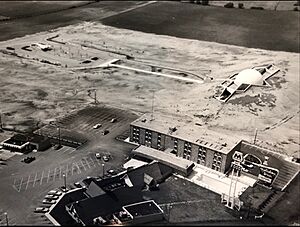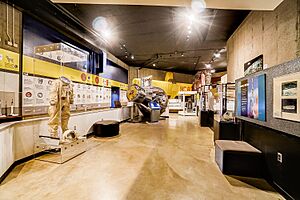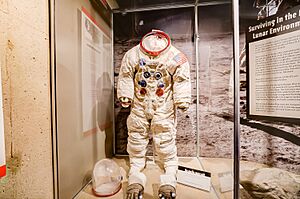- This page was last modified on 17 October 2025, at 10:18. Suggest an edit.
Armstrong Air & Space Museum facts for kids
The Armstrong Air & Space Museum is an exciting museum located in Wapakoneta, Ohio. This town is famous as the hometown of Neil Armstrong, the first person to ever walk on the Moon. The museum opened its doors in 1972. It tells the amazing story of how people from Ohio have helped shape the history of flying and space travel.
Inside the museum, you can see the actual Gemini 8 spacecraft. Neil Armstrong piloted this spacecraft to perform the world's first space docking! You can also see two of Armstrong's real space suits. There are many items from the Apollo Program missions, including a real Moon rock brought back during the Apollo 11 mission. Another cool exhibit is an F5D Skylancer aircraft. The museum has several main areas that show the history of spaceflight. This includes everything from the early days of the Space Race to the end of the Space Shuttle era. In the museum's special Astro-theater, you can watch cool videos and documentaries projected inside a large dome.
The Armstrong Museum is part of a bigger group of museums. These are owned by the Ohio History Connection. The National Aviation Heritage Area (NAHA) also lists the museum as a partner. They recognize it for keeping important items related to aerospace history safe. Even though the museum is named after Neil Armstrong, he was not officially involved with it. He also did not make any money from the museum.
Contents
Neil Armstrong's Early Life
Neil Alden Armstrong was born on August 5, 1930. He was born on his grandparents' farm near Wapakoneta, Ohio. His parents were Stephen and Viola Armstrong. Neil was the oldest of their three children. His father, Stephen, worked as an auditor. This meant he checked the financial records of different counties in Ohio. Because of his father's job, Neil's family moved more than thirteen times when he was a child. They eventually settled back in Wapakoneta in the mid-1940s.
While living in Wapakoneta, Neil finished high school. He also earned his pilot's license from a local airfield. After high school, Neil went to Purdue University. He studied aeronautical engineering there. His college studies were paused when the Navy asked him to serve in the Korean War.
Museum History
On July 21, 1969, Neil Armstrong and Buzz Aldrin were still on the Moon. At that time, Ohio Governor James Rhodes suggested building a museum in Armstrong's hometown. He wanted to honor Neil Armstrong. Governor Rhodes said the museum would celebrate "all Ohioans who attempted to defy gravity." He promised that the State of Ohio would give $500,000 for the project. But the local community had to raise the same amount of money.
People in Wapakoneta started raising money right away. A group of residents formed a special committee. In the first year, over 9,000 people in the area donated money. They raised more than the governor asked for, collecting over $528,000!
Building the Museum
Governor Rhodes chose Dan Porter from the Ohio Historical Society to lead the project. Soon after, a committee was formed. They shared ideas, accepted building plans, and collected important items for the museum. The winning design for the museum was very unique. It looked like a simulated lunar base, similar to what a Moon base might look like.
The building is made of steel-reinforced concrete. It has large earth mounds around it, making it look like it's partly underground. If it were on the Moon, these mounds would protect the base from tiny meteorites and harsh space radiation. The most striking part of the building is its large white dome in the center. This dome would have been a pressure dome if it were on the Moon. Because it's white and linked to the Apollo 11 mission, the dome also reminds people of the Moon. A long, straight walkway with airport landing lights guides visitors to the entrance. This walkway was designed to look like a lunar landing strip.
The construction began on April 16, 1970. It was built on a 16-acre piece of farmland on the east side of the city. Tom Crouch of the Ohio Historical Society was in charge of creating the exhibits inside. Years later, Mr. Crouch became a Curator for the National Air and Space Museum in Washington D.C. Some of the first items in the museum included the Gemini VIII spacecraft, an H-1 rocket engine, and Armstrong's spacesuits.
The museum officially opened on July 20, 1972. This was exactly three years after the historic Moon landing. Neil Armstrong and his family attended the grand opening. Tricia Nixon Cox, daughter of President Richard M. Nixon, was also there. She even brought an Apollo 11 lunar sample to the museum for display! About 10,000 people came to the opening. The doors opened precisely at 2:00 pm.
Museum Updates
The museum had its first big update in the late 1990s. A garden on the south side of the museum was removed. In its place, the Modern Space Gallery was built. This gallery tells the story of space travel after the Apollo Program. It focuses on the Space Shuttle Program and how space travel has continued to grow. This area has two fun interactive simulators. Visitors can try to land a Lunar Module on the Moon. They can also try to land the Space Shuttle on a runway.
Another important update happened in 2019. The Neil Armstrong STEM Inspiration Center was added. This is a classroom space where school groups can do hands-on activities and experiments. The center is also used for many events the museum hosts throughout the year.
In August 2020, the museum received a special donation. It was the first production Learjet 28. Neil Armstrong used this very plane to set five aerospace records! The museum also finished renovating its lobby in January 2024.
Museum Exhibits
Spacecraft and Planes
- Gemini 8 spacecraft: This was flown by Neil Armstrong and David Scott in 1966.
- Douglas F5D Skylancer: A type of jet aircraft.
- Aeronca Champion: This was the first plane Neil Armstrong learned to fly.
- Learjet 28 Longhorn: The only aircraft Neil Armstrong used to set aviation world records.
Space Suits and Clothing
- Neil Armstrong's Gemini 8 spacesuit.
- Neil Armstrong's Apollo 11 backup spacesuit.
- In-flight suit worn by astronaut Eugene Cernan, who was the last man on the Moon.
- Constant wear garment worn by astronaut Jim Lovell.
- Flight garment worn by Ohio astronaut Terence T. Henricks on STS-70.
- A replica pressure suit like those worn by Space Shuttle Program astronauts.
- Soviet hydrosuit: Used in 1978 on Salyut 6.
- Soviet flight suit: Used during the Mir space station era.
Space Items
- United States flag: This flag was taken on the Apollo 11 mission by Neil Armstrong.
- Heel restraints: These were on board the Command Module Columbia during the Apollo 11 mission.
- A lunar sample: This is NASA's term for a Moon rock.
- Apollo 11 heat shield fragment.
- A replica Sputnik I.
- Early space food, hygiene equipment, and sleeping bags.
- Personal items from Ohio astronaut Judith Resnik.
- Shuttle tire from the Space Shuttle Endeavour.






